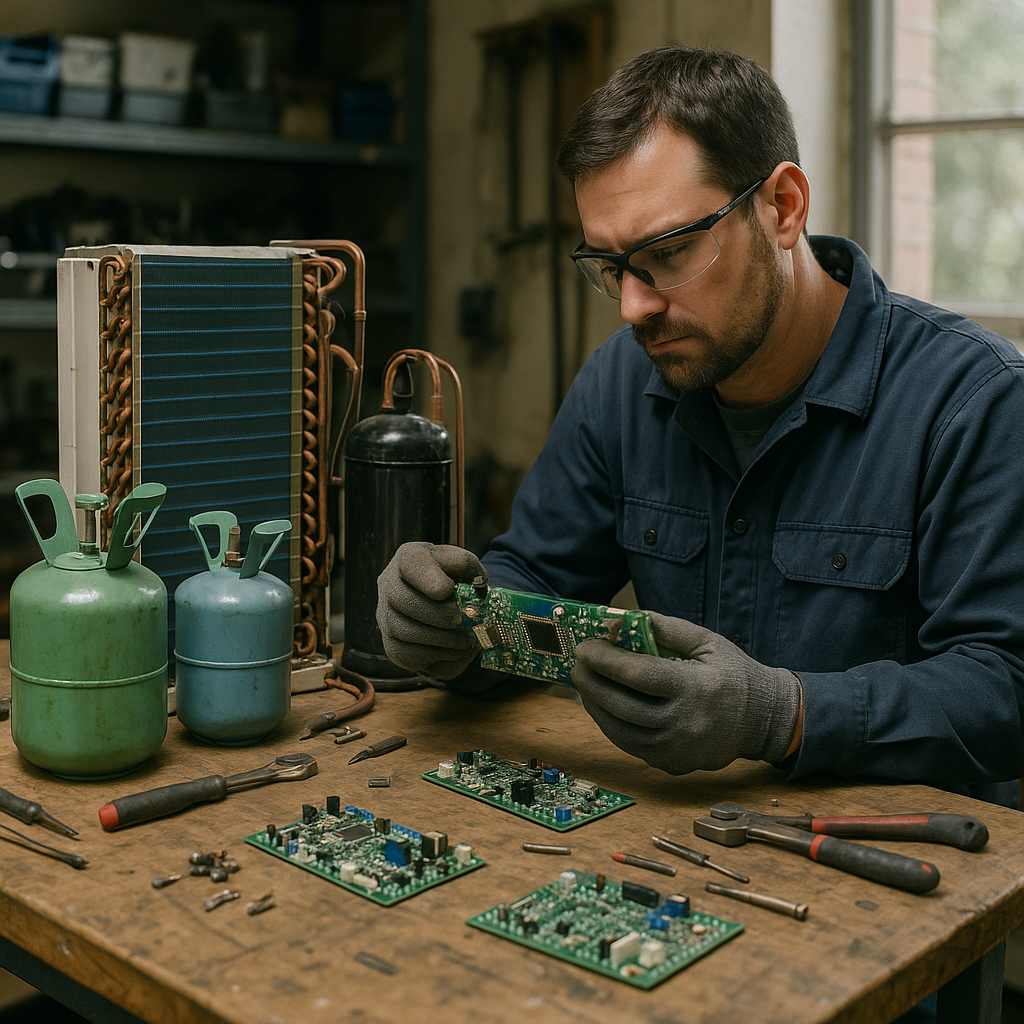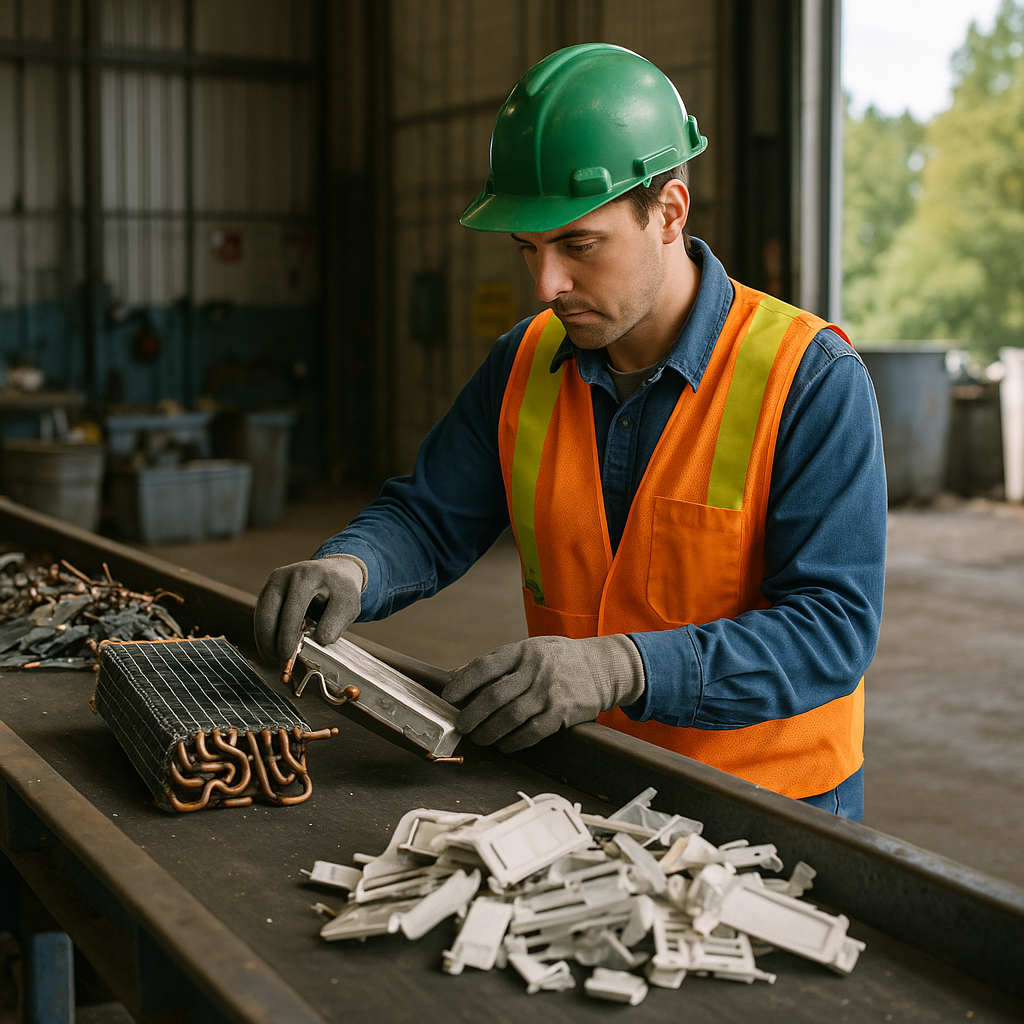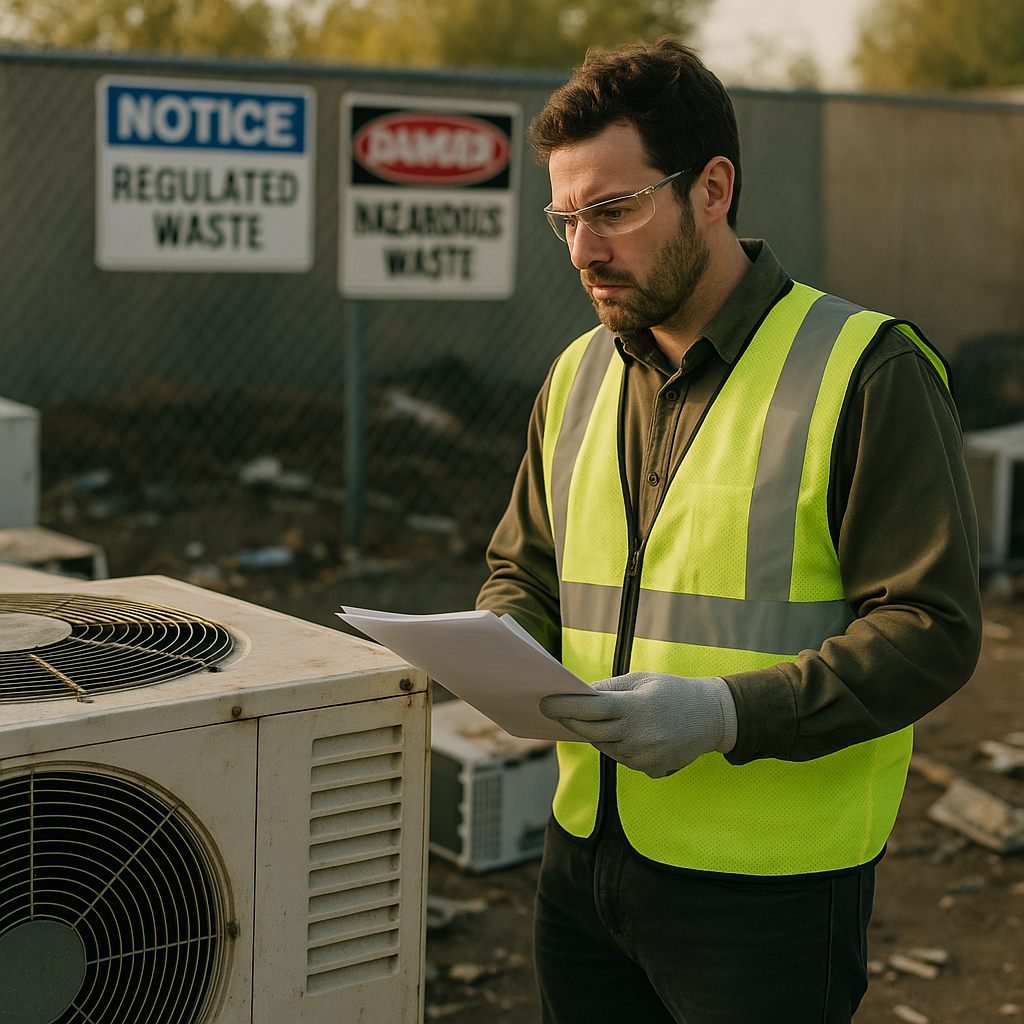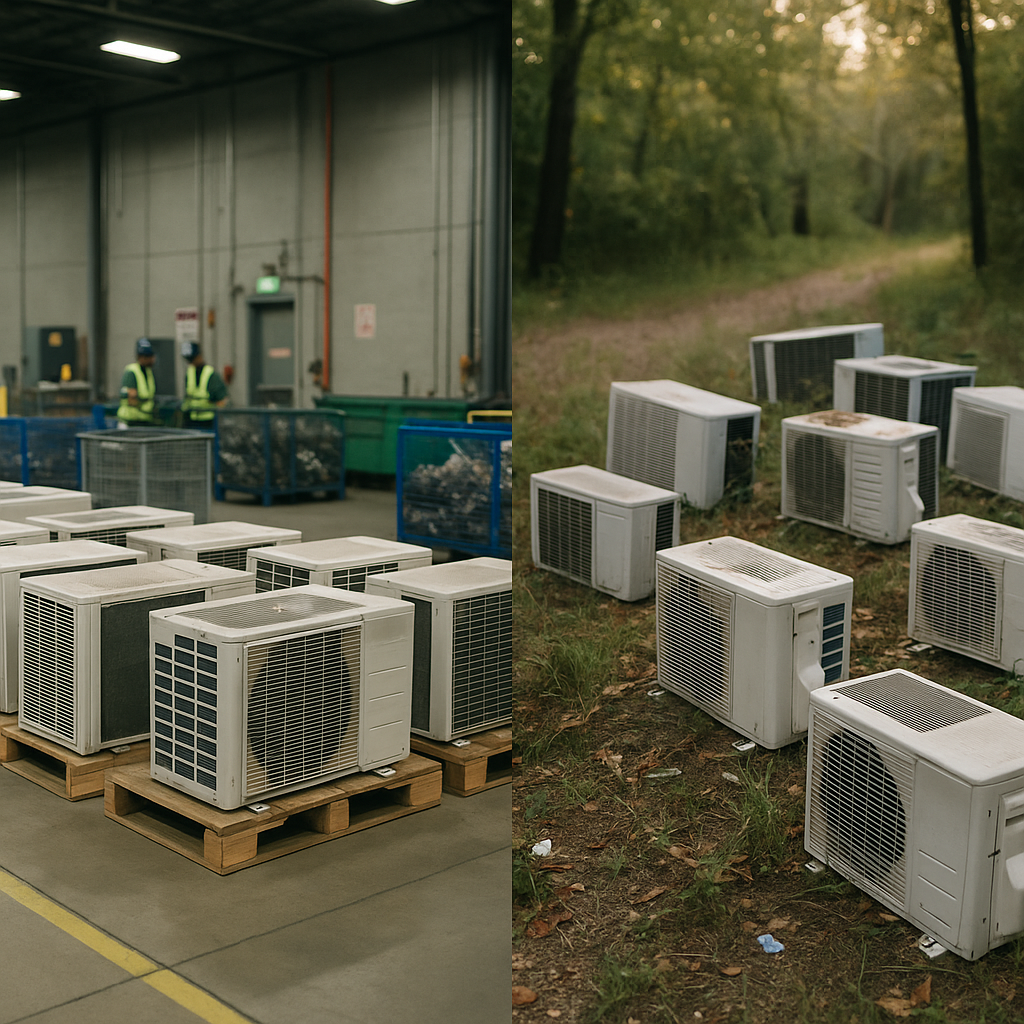5901 Botham Jean Blvd, Dallas, TX 75215
What is the Environmental Impact of Large AC Unit Disposal?
May 28, 2025Did you know that disposing of an air conditioning unit improperly can release greenhouse gases equivalent to driving a car for over 1,000 miles? This fact highlights the critical importance of proper AC unit disposal for our environment.
Large AC units contain refrigerants that pose significant environmental hazards. These chemicals, including chlorofluorocarbons (CFCs) and hydrochlorofluorocarbons (HCFCs), can damage the ozone layer when released into the atmosphere. Modern units often use hydrofluorocarbons (HFCs), which, while less harmful to the ozone, are still powerful greenhouse gases.
These refrigerants have a global warming potential up to 1,000 times greater than carbon dioxide. When improperly handled during disposal, they escape into the air and trap heat, significantly contributing to climate change at a rate far higher than most common pollutants.
What are the Key Components of Large AC Units That Pose Environmental Risks?

Large air conditioning units contain several environmentally hazardous components that require proper handling and recycling. These units are complex appliances with materials that can cause significant environmental damage if improperly disposed of.
Refrigerants: The Primary Environmental Threat
The most environmentally dangerous components in AC units are the refrigerants. Older units may contain chlorofluorocarbons (CFCs) and hydrochlorofluorocarbons (HCFCs), which have been largely phased out due to their destructive impact on the ozone layer.
Modern units typically use hydrofluorocarbons (HFCs), which don’t deplete ozone but are potent greenhouse gases. These refrigerants can be thousands of times more harmful to the climate than carbon dioxide when released into the atmosphere.
A single pound of leaked refrigerant can cause more climate damage than hundreds of pounds of CO2, making proper recovery of these substances critical during the recycling process.
Metals and Their Environmental Impact
AC units contain significant amounts of various metals that pose environmental risks if left in landfills. Copper in cooling coils and wiring is particularly valuable but can contaminate soil and water sources if not properly recycled.
Aluminum components in fins and condenser coils also present environmental concerns. While aluminum itself is 100% recyclable, the extraction process for new aluminum is extremely energy-intensive and environmentally destructive.
Steel housing, brass valves, and other metal components can leach harmful substances into groundwater when improperly disposed of in landfills. These metals take centuries to break down naturally.
Plastics and Electronic Components
Large AC units contain numerous plastic parts, including fan blades, housing components, and insulation materials. These plastics can take hundreds of years to decompose in landfills while releasing harmful chemicals during breakdown.
The electronic circuit boards present in modern AC units often contain hazardous materials like lead, mercury, and cadmium. These toxic substances can contaminate soil and water supplies if not properly handled during disposal.
These circuit boards also contain small amounts of valuable materials like gold, silver, and platinum that can be recovered through specialized recycling processes.
| Component | Environmental Impact |
| Refrigerants (CFCs, HCFCs, HFCs) | High global warming potential, ozone layer depletion |
| Metals (Copper, Aluminum, Steel) | Soil and water contamination if not recycled, energy-intensive extraction |
| Plastics | Non-biodegradable, releases harmful chemicals |
| Electronic Components | Contains hazardous materials like lead and mercury |
The Scale of Recoverable Materials
The recycling potential of large AC units is substantial. Each unit can yield up to 65 pounds of recyclable materials. This includes valuable metals, plastics, and other components that can be repurposed rather than sent to landfills.
Recycling these materials not only prevents environmental contamination but also conserves natural resources. The energy saved by recycling copper from AC units is up to 85% less than what’s required for mining and processing new copper.
The environmental benefits extend beyond material recovery. Steel components can be recycled repeatedly without losing strength, creating a closed-loop system where materials maintain their usefulness across multiple product lifecycles.
Proper Handling Requirements
Due to these environmental risks, AC unit recycling requires specialized handling. The EPA has established specific guidelines for the responsible disposal of air conditioning units.
Certified technicians must safely remove refrigerants before any other processing occurs. These professionals use specialized equipment to capture refrigerants in secure containers for proper recycling or destruction at EPA-certified facilities.
Only after proper refrigerant removal can the unit be dismantled for recovery of other materials. This systematic approach ensures that harmful substances are contained and valuable resources are reclaimed.
How Does Proper AC Unit Recycling Benefit the Environment?

Proper recycling of large AC units provides significant environmental benefits across various ecological dimensions. When these systems reach the end of their useful life, responsible recycling prevents harmful substances from contaminating the environment while conserving valuable resources.
Refrigerant management is perhaps the most critical environmental benefit. Air conditioning systems contain refrigerants like hydrochlorofluorocarbons (HCFCs) and hydrofluorocarbons (HFCs) that pose serious atmospheric threats. These chemicals have global warming potentials much greater than carbon dioxide. When certified technicians safely extract these substances during recycling, they prevent potent greenhouse gases from escaping into the air.
The materials recovery process is another substantial environmental win. A single recycled air conditioner can yield up to 65 pounds of recyclable materials according to EPA data. These units contain valuable metals like copper in cooling coils and electrical wiring, aluminum in condenser coils and structural components, and steel in housings and brackets.
Resource Conservation Impact
The copper recovery aspect delivers impressive environmental returns. Recycling copper from air conditioning systems requires up to 85% less energy than mining and refining new copper, significantly reducing the carbon footprint.
Aluminum components, which make up substantial portions of AC units, are 100% recyclable and maintain their properties indefinitely through the recycling process. Recycling one ton of aluminum conserves approximately 14,000 kilowatt-hours of electricity compared to producing new aluminum from bauxite ore.
Steel components can be recycled repeatedly without degrading quality. Each ton of recycled steel saves 1,400 pounds of coal and 120 pounds of limestone that would otherwise be consumed in producing new steel. This circular approach keeps resources in productive use rather than as waste.
Landfill Reduction and Pollution Prevention
Large AC units take up significant space in landfills when improperly disposed of. Beyond the physical space concerns, these systems contain components that can leach harmful substances into soil and potentially contaminate groundwater.
Proper recycling significantly reduces landfill burden. The specialized recycling process ensures hazardous materials are safely handled and valuable resources are reclaimed. This systematic approach prevents environmental contamination while supporting sustainable resource management.
By reducing demand for new mining operations, AC unit recycling helps preserve natural landscapes and ecosystems. Copper mining operations typically cause deforestation, habitat destruction, and water pollution. Every recycled AC unit directly contributes to decreasing these environmentally damaging activities.
The cumulative impact of responsible AC unit recycling becomes increasingly significant as we face growing environmental challenges. Each unit diverted from landfills represents a meaningful step toward environmental protection and resource conservation.
| Component | Environmental Impact | Recycling Benefit |
|---|---|---|
| Refrigerants (CFCs, HCFCs, HFCs) | High global warming potential, ozone depletion | Prevents greenhouse gas emissions, safe disposal |
| Copper | Soil and water contamination if not recycled | 85% less energy used compared to new mining |
| Aluminum | Energy-intensive extraction | 100% recyclable, conserves energy |
| Steel | Potential groundwater contamination | Recyclable without losing strength |
| Plastics | Long decomposition time, harmful chemical release | Prevents landfill accumulation |
| Electronic Components | Contains hazardous materials like lead and mercury | Recovery of valuable metals like gold |
What are the Legal Requirements for Large AC Unit Disposal?

The disposal of large AC units is regulated by environmental laws aimed at protecting public health and the environment. These regulations focus on the proper handling of refrigerants in air conditioning systems.
The Clean Air Act is fundamental to these regulations in the United States, explicitly prohibiting the release of refrigerants into the atmosphere. The Environmental Protection Agency (EPA) enforces these standards through Section 608, which sets guidelines for handling refrigeration and air conditioning equipment during disposal.
Only EPA-certified technicians are authorized to recover refrigerants from large AC units. This certification ensures that these substances are managed by qualified professionals. The technician must use specialized equipment that meets EPA performance standards to safely extract the refrigerant.
The EPA requires detailed documentation of the refrigerant recovery process, including the location, date of recovery, and type of refrigerant from units containing 5 to 50 pounds of refrigerant. This documentation evidences compliance with federal regulations.
Non-compliance with these regulations carries severe penalties. The EPA can impose fines of up to $37,500 per day for violations of the Clean Air Act. These penalties reflect the environmental impact of improper refrigerant handling. Refrigerants like hydrofluorocarbons (HFCs) are potent greenhouse gases, significantly more damaging than carbon dioxide.
Besides refrigerants, large AC units contain other materials requiring proper handling, such as metals, plastics, and electronic components that should be recycled. Professional recycling services can recover up to 65 pounds of recyclable materials from a single air conditioner, including valuable copper, aluminum, and steel.
For businesses and property managers, the EPA’s Responsible Appliance Disposal (RAD) program offers guidance on best practices. This program promotes the proper recovery of refrigerants and recycling of durable materials, reducing the environmental impact of disposal.
Steps for Legal AC Unit Disposal
To comply with legal requirements when disposing of a large AC unit, follow these steps. First, hire an EPA-certified technician to safely recover all refrigerants from the system. This step is essential and must be completed before dismantling begins.
Next, obtain documentation from the technician confirming refrigerant recovery according to EPA guidelines. Keep these records as proof of compliance, including the technician’s certification number, the date of service, and details about the recovered refrigerant.
After refrigerant recovery, work with a certified recycling facility specializing in HVAC equipment. Many localities have designated facilities or special collection events for large appliances. These facilities ensure hazardous components are managed properly and valuable materials are recovered.
Finally, maintain all disposal records for at least three years. These records may be necessary during EPA inspections or environmental audits. Proper documentation is your best defense against compliance issues or penalties.
| Violation | Penalty | Details |
|---|---|---|
| Improper Disposal of Refrigerants | $37,500 per day | Fines for releasing refrigerants into the atmosphere without proper recovery |
| Non-compliance with Clean Air Act | Up to $145,000 | Penalties for not following EPA guidelines for refrigerant handling |
| Failure to Recover Refrigerant | $442,500 | Settlement for not recovering refrigerants from appliances before disposal |
| Illegal Release of CFCs | $525,000 | Penalties for releasing ozone-depleting gases during appliance disposal |
By following these legal requirements for large AC unit disposal, you avoid significant financial penalties and contribute to environmental protection. Proper handling of refrigerants prevents the release of harmful greenhouse gases, while recycling recovers valuable resources and reduces landfill waste.
Conclusion: The Importance of Responsible Large AC Unit Disposal

Responsible disposal of large AC units is crucial for environmental protection. Proper recycling prevents harmful refrigerants from escaping into the atmosphere, causing more damage than carbon dioxide. It also ensures valuable materials like copper, aluminum, and steel are recovered and reintroduced into the manufacturing process.
Recycling each air conditioner significantly contributes to sustainability. A single unit can yield up to 65 pounds of recyclable materials, reducing the need for new resource extraction and lowering our carbon footprint. As environmental regulations tighten and public awareness grows, choosing responsible AC unit disposal becomes increasingly important. For your commercial or residential AC recycling needs, contact Okon Recycling at 214-717-4083.
